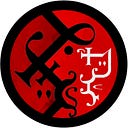The Cobalt Geese
Dabbling with living things had always been a staple of magical studies. The strange creatures produced through magical meddling have always been a source of wonder and disgust, one reason for the fearful respect and alarmed wariness the common people had for wizards. But, with time, even miracles can become a simple thing of life.
Kapuyt, a tengu wizard, was among the first to move to the Valley of Delights to do her research, happy to be protected from torch-wielding mobs or summary arrests by enlightened nobles. Highly respected, she was also the object of an unfortunate stereotype: the crow feature of her heritage made everyone assume she would deal with birds. Kapuyt’s interest was botany, especially flowers (which, to be honest, would be stereotypical in the Beast Nations), making her annoyed at the numerous request for chicken feeds or peacock cosmetics. Circumstances (or maybe destiny) eventually pushed her to embrace others’ assumptions and became a “bird specialist”, creating one of the most successful chimeras: the Cobalt Goose.
Kapuyt was studying a species of hydrangeas that, while proving excellent as a reagent to extend the effect of potions, had the unfortunate side effect of turning the consumer’s hair blue. Technically is not the hair turning blue but the sebum, the natural grease of the scalp, which meant the hair also stained everything it touched. Kapuyt, as many magic scholars do, experiments on herself, turning her feathers blue. In an absent-minded moment, she took one of the feathers used instead of a quill. It kind of worked.
After this lucky accident, Kapuyt elaborates on a way to make self-inking quills. She “primed” some geese dipping their eggs in a special potion and then fed them hydrangeas and a special feeding made of wheat and cobalt salts. While growing the geese get bluer and bluer feathers, of a deep and vibrant hue. Feathers of such geese are imbued with an ink-like substance, making them writing utensils that last as long as an ordinary pen and inkwell.
The priming ointment and the cobalt feed are both magical but very easy to enchant, something an apprentice could easily do, and since hydrangeas are among the ingredient, they can stay active for weeks, making them able to be shipped.
In thirty years, Blue Geese farming has become an industry in Madomini. Kapuyt has become filthy rich selling the quills and the “protocol” to breed the birds. Now, in her twilight years, she retired, bleaching her feather white as a sign of a new phase: she is gone back to botany, spending her fortune to create the most beautiful and complete herbarium of the Empire. a garden guarded, of course, by a gaggle of blue geese.
The Blue Geese have become a staple of Maladomini farming and uses, customs, and stories have arisen. Shepherding geese has always been a kids’ job: the geese are aggressive enough to take care of themselves and their carer, so even a child can take a gaggle alone to pasture. The Cobalt Geese are quite an investment: the special feed needed to make the color vibrant has its cost and has to be dosed with care. Girls, with their reputation of being more mature than their brothers, have been usually tasked to care after them instead of boys. Handling the feeding stains the girls’ hands and gives them an exotic beauty mark: they have blue freckles.
The image of these young girls, strolling the country roads surrounded by bluebirds with their eyes underlined by equally blue freckles has sparked the imagination of writers of all sorts. They have become an idealized symbol of magical farming, icons of the harmonious mix between the bucolic and the arcane. Geese maidens have to go to towns often to sell their quills to notaries and other professionals, but they have a special relationship with wizards most of all.
The image of the geese girl visiting the wizard to sell him the pens has been fodder for many stories. For example, there are the stock characters of Azura and Claudio, a wise and pragmatic girl mocking the clumsy and absent-minded wizard, very popular in marionette shows. There is also “Teaching Celeste”, a cycle of songs where a geese girl is able to demonstrate her intelligence to the arrogant wizard, becoming eventually her student. It also freshly debuted the opera “Cobaltine” narrating the unrequired love of a wizard for a geese girl. The are a couple of memorable duets, with the deep basso of arcanist entwined with the high soprano of the girl, but the plot was deemed too convoluted with too many revelations and an unsatisfying ending: Cobalitne is actually the lost daughter of the wizard and she ends up with the sheep farm, who is, in reality, a war hero (a forced happy ending, just to make it fit in the Autumn Opera genre).
Part of what makes the Geese Girl fascinating, being so young but with responsibilities, is also their tragedy. The alchemical cobalt salts are toxic, not much, but enough that after years of handling them, they will develop lung problems and have to stop. The bright blue that colored their fingertips and cheek will become a dull purplish brown and they will have an annoying chronic cough. Not an exciting end of a career, but their inevitable and frequent turnover it’s what makes the Geese Girls of the imagination eternally young.
